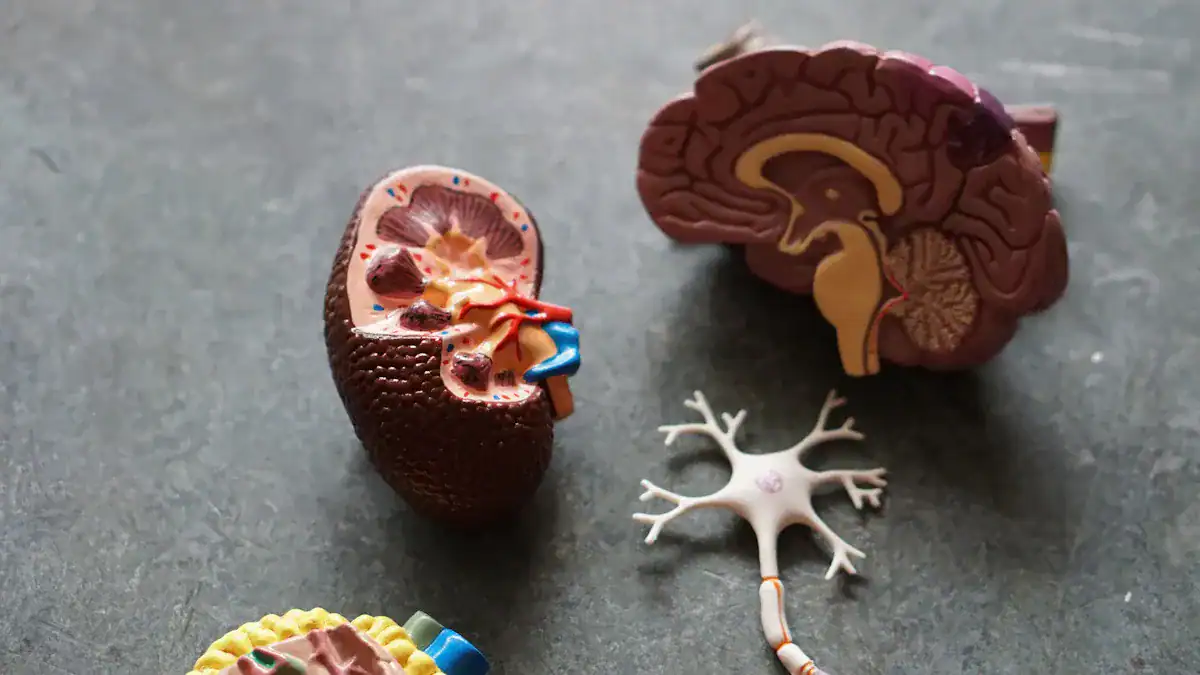
The gallbladder is located in the upper right abdomen, directly beneath the liver. This small, pear-shaped organ is about 7 to 10 centimeters long and primarily functions to store bile. This quick overview of gallbladder anatomy explains its function and general structure. Understanding where the gallbladder is located helps us appreciate this vital organ.
Key Takeaways
The gallbladder is in your upper right belly, under your liver. It stores bile, which helps digest fats.
The gallbladder makes bile stronger and releases it when you eat fatty foods. This helps your body break down fats.
Gallstones and inflammation are common gallbladder problems. See a doctor if you have bad belly pain, especially after eating.
Where The Gallbladder Is

The gallbladder holds a specific place within the human body. Understanding its exact position helps in comprehending its role in digestion. This section details the precise gallbladder anatomy and its location.
Upper Right Abdomen
The gallbladder resides in the upper right abdomen. This area is on the right side of your belly, just below the ribcage. It sits between the 4th and 9th ribs on the right side. The gallbladder is also located behind the lower portion of the right ribcage. Its front and top parts relate to the liver’s lower edge and the front abdominal wall. The gallbladder fundus projects into the liver’s lower surface.
Under The Liver
The gallbladder is found directly underneath the liver. It rests in a small depression on the liver’s underside. This depression is called the gallbladder fossa. The gallbladder sits on the visceral surface of the liver. It is positioned between the right and quadrate lobes of the liver. The gallbladder body lies within this fossa. This close relationship allows the gallbladder to work with the liver in processing bile.
Anatomical Position
The gallbladder is an intraperitoneal organ. This means it is mostly covered by the peritoneum, a membrane lining the abdominal cavity. It occupies the right hypochondrial region of the abdomen.
The gallbladder neck connects to the cystic duct, which is part of the biliary tract. Behind the gallbladder, it is close to the transverse colon and the first part of the small intestine, called the proximal duodenum. Below the gallbladder, it connects with the biliary tree and other parts of the duodenum. This detailed anatomy shows how the gallbladder interacts with surrounding organs.
Gallbladder Function
The gallbladder performs several vital functions within the digestive system. It works closely with the liver to manage bile, a crucial fluid for breaking down fats. This section explains the primary roles of the gallbladder.
Bile Storage
The gallbladder primarily stores bile. The liver continuously produces this digestive fluid. Bile helps the body break down fats. The gallbladder acts as a reservoir, holding bile until the body needs it. The average fasting volume of bile stored in the gallbladder in healthy individuals is between 25 to 30 mL. The gallbladder typically has a volume of 40 to 50 mL. Only 40-75 mL of bile is stored in the gallbladder daily. If the cystic duct becomes blocked, the gallbladder can hold up to 300 mL.
Bile Concentration
The gallbladder also concentrates bile. This process removes water and certain ions from the bile. The gallbladder’s inner lining, called the mucosa, has simple columnar epithelium. This lining absorbs water and ions from the bile. This absorption allows the gallbladder to concentrate bile by as much as tenfold. Concentrated bile is more effective for digestion.
Bile contains many components. These include organic molecules like bile acids (cholic acid and chenodeoxycholic acid), phospholipids, cholesterol, and bile pigments (bilirubin). It also has inorganic salts such as sodium, potassium, calcium, and bicarbonate. Glutathione (GSH) is another significant organic molecule present in bile.
Digestion Role
The gallbladder plays a crucial role in digestion. When a person eats fatty foods, the gallbladder releases bile into the small intestine. A hormone called cholecystokinin (CCK) triggers this release. Enteroendocrine I-cells in the upper small intestine produce CCK. Its levels increase after meals rich in fat and protein. CCK stimulates the gallbladder to contract.
This action empties bile into the duodenum, the first part of the small intestine. CCK also relaxes the sphincter of Oddi, which allows bile to flow. This entire process is vital for fat emulsification. Bile contains bile salts, lecithin, and cholesterol derivatives. These act as emulsifiers.
They break large fat globules into smaller particles. This increases the surface area of lipids. Digestive enzymes can then work on the fats more easily. Bile salts then form micelles with fatty acids and monoglycerides. Micelles have a fatty core and a water-soluble exterior. This structure helps transport fats to the intestinal microvilli for absorption. The bloodstream then absorbs these fatty acids. The body uses them for energy. This complex anatomy and function ensure proper fat digestion.
Common Gallbladder Issues
The gallbladder can develop several problems. These issues often cause discomfort or pain. Understanding these common conditions helps people recognize when to seek medical help.
Gallstones
Gallstones are hardened deposits of digestive fluid. They form in the gallbladder. Approximately 20% of adults develop gallstones in their lifetime. This makes them one of the most common gastrointestinal diseases in Western countries. Several factors increase the risk of developing gallstones.
These include being female, 40 years or older, or of Native American or Hispanic of Mexican origin. Lifestyle choices also play a role. Being overweight or obese, leading a sedentary life, or experiencing rapid weight loss can contribute. Dietary factors like eating a high-fat, high-cholesterol, or low-fiber diet also increase risk. Certain medications, such as estrogen-containing drugs, can also be a factor.
Cholecystitis
Cholecystitis is inflammation of the gallbladder. Gallstones are the most common cause of this condition. They account for 95% of all cholecystitis cases. Gallstones block the cystic duct, which leads to bile buildup.
This blockage causes irritation, pressure, and swelling in the gallbladder. Other causes include serious illnesses like HIV or diabetes. Rarely, tumors in the gallbladder can also cause cholecystitis.
Key Symptoms
People with gallbladder problems often experience specific symptoms. Biliary colic is a common type of pain. This pain comes on suddenly and strongly. It then gradually fades.
The pain is often severe, described as intense, sharp, or cramping. It can last longer than 30 minutes, sometimes for a few hours. This pain is typically felt in the middle to right upper abdomen. It can spread to the right shoulder blade. Nausea and vomiting often accompany this pain. Fatty meals or large meals can trigger it. You should seek immediate medical attention if gallbladder attack symptoms last more than two hours. A fever or severe, intolerable pain also requires urgent care.
Understanding Gallbladder Anatomy

Understanding the gallbladder anatomy helps clarify its role in digestion. This section reinforces the structural aspects of this small but vital organ. It also covers how to maintain its health and when to seek medical advice.
Organ Structure
The gallbladder has a complex structure. Its wall consists of several layers. The innermost layer is the mucosa. It has many folds when the gallbladder is empty. This layer includes simple columnar epithelium and lamina propria. The lamina propria is connective tissue with small blood vessels.
Next is the tunica muscularis. This layer has smooth muscle bundles. They contract to empty the gallbladder. The outer layer is connective tissue. It is called adventitia where the gallbladder attaches to the liver. It is called serosa where the gallbladder is free.
The gallbladder lacks a muscularis mucosae or submucosa. The cystic duct connects to the gallbladder neck. This connection is important. This duct has spiral folds called the spiral valve of Heister. These folds help support the duct. They also moderate bile flow. They keep the duct open to prevent kinking. The gallbladder fundus is the rounded end. The gallbladder body is the main part. The gallbladder neck narrows towards the cystic duct. The gallbladder fundus often extends beyond the liver’s edge. This detailed anatomy helps understand its function.
Health Considerations
Maintaining gallbladder health is important. Lifestyle changes can help prevent problems. Eating a low-fat, high-fiber diet is beneficial. Include plenty of fruits and vegetables. Choose lean meats and fish. Whole grains are better than refined carbohydrates. Low-fat dairy products are also good choices. Nuts can reduce gallstone chances.
Drinking enough water helps the gallbladder empty. Regular physical activity also lowers disease risk. These healthy habits support overall anatomy and function. Diagnostic tests help evaluate gallbladder health. Doctors use ultrasound to find gallstones. CT scans identify tears or infections. MRI finds stones in bile ducts. Blood tests can also indicate issues.
When To Consult A Doctor
Recognizing warning signs is crucial for gallbladder health. Seek medical attention for persistent abdominal pain. Pain in the upper right abdomen or below the breastbone needs evaluation. Pain spreading to the back or right shoulder is also a concern. Nausea and vomiting often accompany these pains. A high fever with chills requires immediate care.
Yellow skin or eyes, called jaundice, is a serious symptom. Intense abdominal pain that prevents comfort also needs urgent medical help. Untreated gallbladder issues can lead to serious complications. These include tissue death in the gallbladder or pus accumulation. Gallstones can block bile ducts. This causes inflammation or liver problems. Early consultation helps manage these conditions. Understanding where the gallbladder located is helps identify potential problem areas.
The gallbladder is located in the upper right abdomen, tucked under the liver. This small organ stores and concentrates bile for fat digestion. Its unique anatomy supports this function. Recognizing common gallbladder issues is important. The gallbladder plays a small but vital role in your digestive system anatomy.
FAQ
What is the gallbladder’s main job?
The gallbladder stores and concentrates bile. It releases bile into the small intestine. This helps the body digest fats from food.
What are gallstones?
Gallstones are hard deposits. They form in the gallbladder. These stones consist of digestive fluid. They can cause pain and block bile flow.
What is cholecystitis?
Cholecystitis is inflammation of the gallbladder. Gallstones often cause this condition. It leads to pain, swelling, and discomfort in the abdomen.




